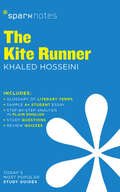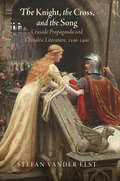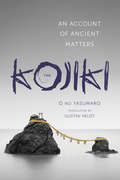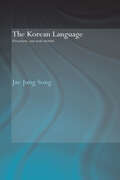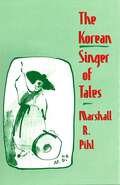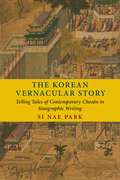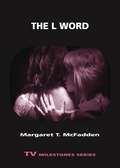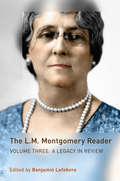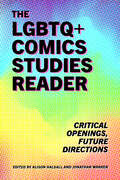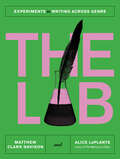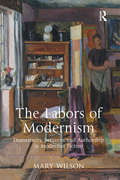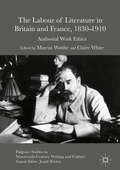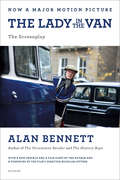- Table View
- List View
The Kite Runner (SparkNotes Literature Guide Series #40)
by SparkNotesThe Kite Runner (SparkNotes Literature Guide) by Khaled Hosseini Making the reading experience fun! When a paper is due, and dreaded exams loom, here's the lit-crit help students need to succeed! SparkNotes Literature Guides make studying smarter, better, and faster. They provide chapter-by-chapter analysis; explanations of key themes, motifs, and symbols; a review quiz; and essay topics. Lively and accessible, SparkNotes is perfect for late-night studying and paper writing. Includes:An A+ Essay—an actual literary essay written about the Spark-ed book—to show students how a paper should be written.16 pages devoted to writing a literary essay including: a glossary of literary termsStep-by-step tutoring on how to write a literary essayA feature on how not to plagiarize
The Kite and the String: How to Write with Spontaneity and Control--and Live to Tell the Tale
by Alice MattisonA targeted and insightful guide to the stages of writing fiction and memoir without falling into common traps, while wisely navigating the writing life, from an award-winning author and longtime teacherWriting well does not result from following rules and instructions, but from a blend of spontaneity, judgment, and a wise attitude toward the work--neither despairing nor defensive, but clear-eyed, courageous, and discerning. Writers must learn to tolerate the early stages, the dreamlike and irrational states of mind, and then to move from jottings and ideas to a messy first draft, and onward into the work of revision. Understanding these stages is key.The Kite and the String urges writers to let playfulness and spontaneity breathe life into the work--letting the kite move with the winds of feeling--while still holding on to the string that will keep it from flying away. Alice Mattison attends also to the difficulties of protecting writing time, preserving solitude, finding trusted readers, and setting the right goals for publication. The only writing guide that takes up both the stages of creative work and developing effective attitudes while progressing through them, plus strategies for learning more about the craft, The Kite and the String responds to a pressing need for writing guidance at all levels.
The Knight, the Cross, and the Song: Crusade Propaganda and Chivalric Literature, 1100-1400 (The Middle Ages Series)
by Stefan Vander ElstThe Knight, the Cross, and the Song offers a new perspective on the driving forces of crusading in the period 1100-1400. Although religious devotion has long been identified as the primary motivation of those who took the cross, Stefan Vander Elst argues that it was by no means the only focus of the texts written to convince the warriors of Western Christianity to participate in the holy war. Vander Elst examines how, across three centuries, historiographical works that served as exhortations for the Crusade sought specifically to appeal to aristocratic interests beyond piety. They did so by appropriating the formal and thematic characteristics of literary genres favored by the knightly class, the chansons de geste and chivalric romance. By using the structure, commonplaces, and traditions of chivalric literature, propagandists associated the Crusade with the decidedly secular matters to which arms-bearers were drawn. This allowed them to introduce the mutual obligation between lord and vassal, family honor, the thirst for adventure, and even the desire for women as parallel and complementary motivations for Crusade, making chivalric and literary concerns an indelible part of the ideology and practice of holy war.Examining English, Latin, French, and German texts, ranging from the twelfth-century Gesta Francorum and Chanson d'Antioche to the fourteenth-century Krônike von Prûzinlant and La Prise d'Alixandre, The Knight, the Cross, and the Song traces the historical development and geographical spread of this innovative use of secular chivalric fiction both to shape the memory and interpretation of past events and to ensure the continuation of the holy war.
The Knights of Modernism: The Chivalric Ideal in the World Novel of the 20th Century (Schriften zur Weltliteratur/Studies on World Literature #12)
by Branko VranešAccording to the customary literary-historical and theoretical notion, the fact that the first modern novel represents a parody or travesty of the chivalric ideal merits no particular attention. Failing to become attuned to the real role of the chivalric ideal at the beginning of the era of the modern novel, commentators missed the chance to adequately review the role of chivalry at the end of that period. The modern novel did not only begin, but also ended with a travesty of the chivalric ideal. The deep need of a significant number of modernist writers to measure their own time according to the ideals of the high and late Middle Ages cannot, therefore, be explained by a set of literary-historical, spiritual-historical or social circumstances. The predilection of a range of twentieth century novelists for a distant feudal past suggests that there exists a fundamental poetic connection between the modern (or at least the modernist) novel and the ideals of chivalry.
The Kojiki
by Gustav HeldtChronicles the mythical origins of Japan's islands and their ruling dynasty through a diverse array of genealogies, tales, and songs
The Kokinshū: Selected Poems (Translations from the Asian Classics)
by Torquil DuthieCompiled in the early tenth century, the Kokinshū is an anthology of some eleven hundred poems that aimed to elevate the prestige of vernacular Japanese poetry at the imperial court. From shortly after its completion to the end of the nineteenth century, it was celebrated as the cornerstone of the Japanese vernacular poetic tradition. The composition of classical poetry, other later poetic forms such as linked verse and haikai, and vernacular Japanese literary writing in its entirety (including classic works such as Murasaki Shikibu’s Tale of Genji and Sei Shōnagon’s Pillow Book) all draw from the Kokinshū.This book offers an inviting and immersive selection of roughly one-third of the anthology in English translation. Torquil Duthie focuses on rendering the poetic language of the Kokinshū as a whole, in such a way that readers can understand and experience how its poems work together to create a literary world. He emphasizes that classical Japanese poems do not stand alone as self-contained artifacts but take part in an ongoing intertextual conversation. Duthie provides translations and interpretations of the two prefaces to the Kokinshū, which deeply influenced Japanese literary aesthetics. The book also includes critical essays on various aspects of the anthology and its history. This translation helps specialist and nonspecialist readers alike appreciate the beauty and richness of the Kokinshū, as well as its significance for the Japanese literary tradition.
The Korean Language: Structure, Use and Context
by Jae Jung SongSuitable for students of all levels, this book provides a general description of the Korean language by highlighting important structural aspects whilst keeping technical details to a minimum. By examining the Korean language in its geographical, historical, social and cultural context the reader is able to gain a good understanding of its speakers and the environment in which it is used. The book covers a range of topics on Korean including its genetic affiliation, historical development, sound patterns, writing systems, vocabulary, grammar and discourse. The text is designed to be accessible, primarily to English-speaking learners of Korean and scholars working in disciplines other than linguistics, as well as serving as a useful introduction for general linguists. The book complements Korean language textbooks used in the classroom and will be welcomed not only by readers with a wider interest in Korean studies, but also by Asian specialists in general.
The Korean Singer of Tales (Harvard-Yenching Institute Monograph Series #37)
by Marshall R. PihlP'ansori, the traditional oral narrative of Korea, is sung by a highly trained soloist to the accompaniment of complex drumming. The singer both narrates the story and dramatizes all the characters, male and female. Performances require as long as six hours and make extraordinary vocal demands. In the first book-length treatment in English of this remarkable art form, Pihl traces the history of p'ansori from its roots in shamanism and folktales through its nineteenth-century heyday under highly acclaimed masters and discusses its evolution in the twentieth century. After examining the place of p'ansori in popular entertainment and its textual tradition, he analyzes the nature of texts in the repertoire and explains the vocal and rhythmic techniques required to perform them.Pihl's superb translation of the alternately touching and comic "Song of Shim Ch'ong"—the first annotated English translation of a full p'ansori performance text—illustrates the emotional range, narrative variety, and technical complexity of p'ansori literature. The Korean Singer of Tales will interest not only Korean specialists, but also students of comparative literature, folklore, anthropology, and music.
The Korean Vernacular Story: Telling Tales of Contemporary Chosŏn in Sinographic Writing
by Si Nae ParkAs the political, economic, and cultural center of Chosŏn Korea, eighteenth-century Seoul epitomized a society in flux: It was a bustling, worldly metropolis into which things and people from all over the country flowed. In this book, Si Nae Park examines how the culture of Chosŏn Seoul gave rise to a new vernacular narrative form that was evocative of the spoken and written Korean language of the time.The vernacular story (yadam) flourished in the nineteenth century as anonymously and unofficially circulating tales by and for Chosŏn people. The Korean Vernacular Story focuses on the formative role that the collection Repeatedly Recited Stories of the East (Tongp’ae naksong) played in shaping yadam, analyzing the collection’s language and composition and tracing its reception and circulation. Park situates its compiler, No Myŏnghŭm, in Seoul’s cultural scene, examining how he developed a sense of belonging in the course of transforming from a poor provincial scholar to an urbane literary figure. No wrote his tales to serve as stories of contemporary Chosŏn society and chose to write not in cosmopolitan Literary Sinitic but instead in a new medium in which Literary Sinitic is hybridized with the vernacular realities of Chosŏn society. Park contends that this linguistic innovation to represent tales of contemporary Chosŏn inspired readers not only to circulate No’s works but also to emulate and cannibalize his stylistic experimentation within Chosŏn’s manuscript-heavy culture of texts.The first book in English on the origins of yadam, The Korean Vernacular Story combines historical insight, textual studies, and the history of the book. By highlighting the role of negotiation with Literary Sinitic and sinographic writing, it challenges the script (han’gŭl)-focused understanding of Korean language and literature.
The L Word
by Margaret T. McfaddenIn January 2004, Showtime debuted The L Word, the first prime-time commercial drama to center around lesbian characters. Over the course of six seasons, the show depicted the lives and loves of an evolving circle of friends in West Hollywood, California, and was widely read as evidence of changing social attitudes toward gay people. Building on immediate critical attention, the show reigned as Showtime's most popular for its first three seasons and earned a large and enthusiastic audience. In The L Word, author Margaret T. McFadden argues that the show is important for its subject matter, its extended and deeply literate commentary on the history of representation of lesbians in popular media, and the formal innovations it deployed to rewrite that history. McFadden shows that the program's creators, led by executive producer Ilene Chaiken, were well aware of the assumptions and expectations that viewers would bring to it after a history of stereotypical depictions of lesbians on television. They sought to satisfy a diverse group of viewers who wanted honest and appealing portrayals of their lives while still attracting a large enough mainstream audience to make The L Word commercially viable. In five chapters, McFadden explores how the show tackled these problems of representation by using reflexivity as a strategy to make meaning, undertaking a complicitous critique of Hollywood, skillfully using a soap-drama format to draw in its audience, and ultimately creating its own complex representation of a lesbian community. While deconstructing the history of misrepresentation of lesbians, The L Word's new modes of storytelling and new perspectives made many aspects of lesbian experience, history, and culture visible to a large audience. Fans of the show as well as readers interested in cultural studies and gay and lesbian pop cultural history will enjoy this astute volume.
The L.M. Montgomery Reader
by Benjamin LefebvreThe L.M. Montgomery Reader assembles significant rediscovered primary material on one of Canada's most enduringly popular authors throughout her high-profile career and after her death. Each of its three volumes gathers pieces published all over the world to set the stage for a much-needed reassessment of Montgomery's literary reputation. Much of the material is freshly unearthed from archives and digital collections and has never before been published in book form.The selections appearing in this first volume focus on Montgomery's role as a public celebrity and author of the resoundingly successful Anne of Green Gables (1908). They give a strong impression of her as a writer and cultural critic as she discusses a range of topics with wit, wisdom, and humour, including the natural landscape of Prince Edward Island, her wide readership, anxieties about modernity, and the continued relevance of "old ideals." These essays and interviews, joined by a number of additional pieces that discuss her work's literary and cultural value in relation to an emerging canon of Canadian literature, make up nearly one hundred selections in all.Each volume is accompanied by an extensive introduction and detailed commentary by leading Montgomery scholar Benjamin Lefebvre that trace the interplay between the author and the critic, as well as between the private and the public Montgomery. This volume - and the Reader as a whole - adds tremendously to our understanding and appreciation of Montgomery's legacy as a Canadian author and as a literary celebrity both during and beyond her lifetime.
The L.M. Montgomery Reader: Volume Three
by Benjamin LefebvreThe final volume of The L.M. Montgomery Reader, A Legacy in Review examines a long overlooked portion of Montgomery's critical reception: reviews of her books. Although Montgomery downplayed the impact that reviews had on her writing career, claiming to be amused and tolerant of reviewers' contradictory opinions about her work, she nevertheless cared enough to keep a large percentage of them in scrapbooks as an archive of her career.Edited by leading Montgomery scholar Benjamin Lefebvre, this volume presents more than four hundred reviews from eight countries that raise questions about and offer reflections on gender, genre, setting, character, audience, and nationalism, much of which anticipated the scholarship that has thrived in the last four decades. Lefebvre's extended introduction and chapter headnotes place the reviews in the context of Montgomery's literary career and trace the evolution of attitudes to her work, and his epilogue examines the reception of Montgomery's books that were published posthumously.A comprehensive account of the reception of Montgomery's books, published during and after her lifetime, A Legacy in Review is the illuminating final volume of this important new resource for L.M. Montgomery scholars and fans around the world.
The LEGO Games Book: 50 Fun Brainteasers, Games, Challenges, and Puzzles!
by Tori KosaraBuild in some time for fun!Who can stack the tallest tower in 60 seconds? Can anyone solve the puzzle cube? With more than 50 fun challenges, puzzles, brainteasers, and games, get out your LEGO® bricks and put your friends and family to the test.©2020 The LEGO Group.
The LGBTQ+ Comics Studies Reader: Critical Openings, Future Directions
by Alison Halsall and Jonathan WarrenWinner of the 2023 Eisner Award for Best Academic/Scholarly WorkContributions by Michelle Ann Abate, William S. Armour, Alison Bechdel, Jennifer Camper, Tesla Cariani, Matthew Cheney, Hillary Chute, Edmond (Edo) Ernest dit Alban, Ramzi Fawaz, Margaret Galvan, Justin Hall, Alison Halsall, Lara Hedberg, Susanne Hochreiter, Sheena C. Howard, Rebecca Hutton, remus jackson, Keiko Miyajima, Chinmay Murali, Marina Rauchenbacher, Katharina Serles, Sathyaraj Venkatesan, Jonathan Warren, and Lin YoungThe LGBTQ+ Comics Studies Reader explores the exemplary trove of LGBTQ+ comics that coalesced in the underground and alternative comix scenes of the mid-1960s and in the decades after. Through insightful essays and interviews with leading comics figures, volume contributors illuminate the critical opportunities, current interactions, and future directions of these comics. This heavily illustrated volume engages with the work of preeminent artists across the globe, such as Howard Cruse, Edie Fake, Justin Hall, Jennifer Camper, and Alison Bechdel, whose iconic artwork is reproduced within the volume. Further, it addresses and questions the possibilities of LGBTQ+ comics from various scholarly positions and multiple geographical vantages, covering a range of queer lived experience. Along the way, certain LGBTQ+ touchstones emerge organically and inevitably—pride, coming out, chosen families, sexual health, gender, risk, and liberation. Featuring comics figures across the gamut of the industry, from renowned scholars to emerging creators and webcomics artists, the reader explores a range of approaches to LGBTQ+ comics—queer history, gender and sexuality theory, memory studies, graphic medicine, genre studies, biography, and more—and speaks to the diversity of publishing forms and media that shape queer comics and their reading communities. Chapters trace the connections of LGBTQ+ comics from the panel, strip, comic book, graphic novel, anthology, and graphic memoir to their queer readership, the LGBTQ+ history they make visible, the often still quite fragile LGBTQ+ distribution networks, the coded queer intelligence they deploy, and the community-sustaining energy and optimism they conjure. Above all, The LGBTQ+ Comics Studies Reader highlights the efficacy of LGBTQ+ comics as a kind of common ground for creators and readers.
The Lab: Experiments in Writing Across Genre
by Alice LaPlante Matthew Clark DavisonGreat writing doesn’t begin with form—it begins with obsession. Two novelists offer an inspiring guide to transforming that obsession, using whatever genre fits best. Writers don’t need formulas; they need encouragement to take risks. The Lab offers a bold, hands-on approach, urging writers to embrace uncertainty, experiment with form, and investigate what haunts them. The Lab features ten chapters and ninety exercises challenging writers to play with fiction, memoir, and poetry—or push toward hybrid or entirely new forms. This is a book for those ready to dig deep and write fearlessly.
The Labor of Literature: Democracy and Literary Culture in Modern Chile
by Jane D. GriffinBy producing literature in nontraditional forms—books made of cardboard trash, posters in subway stations, miniature shopping bags, digital publications, and even children’s toys—Chileans have made and circulated literary objects in defiance of state censorship and independent of capitalist definitions of value. In The Labor of Literature Jane D. Griffin studies amateur and noncommercial forms of literary production in Chile that originated in response to authoritarian state politics and have gained momentum throughout the postdictatorship period. She argues that such forms advance a model of cultural democracy that differs from and sometimes contradicts the model endorsed by the state and the market. By examining alternative literary publications, Griffin recasts the seventeen-year Pinochet dictatorship as a time of editorial experimentation despite widespread cultural oppression and shows how grassroots cultural activism has challenged government-approved corporate publishing models throughout the postdictatorship period. Griffin’s work also points to the growing importance of autogestión, or do-it-yourself cultural production, where individuals combine artisanal forms with new technologies to make and share creative work on a global scale.
The Labors of Modernism: Domesticity, Servants, and Authorship in Modernist Fiction
by Mary WilsonIn The Labors of Modernism, Mary Wilson analyzes the unrecognized role of domestic servants in the experimental forms and narratives of Modernist fiction by Virginia Woolf, Gertrude Stein, Nella Larsen, and Jean Rhys. Examining issues of class, gender, and race in a transatlantic Modernist context, Wilson brings attention to the place where servants enter literature: the threshold. In tracking their movements across the architectural borders separating indoors and outdoors and across the physical doorways between rooms, Wilson illuminates the ways in which the servants who open doors symbolize larger social limits and exclusions, as well as states of consciousness. The relationship between female servants and their female employers is of particular importance in the work of female authors, for whom the home and the novel are especially interconnected sites of authorization and domestication. Modernist fiction, Wilson shows, uses domestic service to tame and interrogate not only issues of class, but also the overlapping distinctions of racial and ethnic identities. As Woolf, Stein, Larsen, and Rhys use the novel to interrogate the limitations of gendered domestic ideologies, they find they must deploy these same ideologies to manage the servant characters whose labor maintains the domestic spaces they find limiting. Thus the position of servants in these texts forces the reader to recognize servants not just as characters, but as conditions for the production of literature and of the homes in which literature is created.
The Labors of Modernism: Domesticity, Servants, and Authorship in Modernist Fiction
by Mary WilsonIn The Labors of Modernism, Mary Wilson analyzes the unrecognized role of domestic servants in the experimental forms and narratives of Modernist fiction by Virginia Woolf, Gertrude Stein, Nella Larsen, and Jean Rhys. Examining issues of class, gender, and race in a transatlantic Modernist context, Wilson brings attention to the place where servants enter literature: the threshold. In tracking their movements across the architectural borders separating indoors and outdoors and across the physical doorways between rooms, Wilson illuminates the ways in which the servants who open doors symbolize larger social limits and exclusions, as well as states of consciousness. The relationship between female servants and their female employers is of particular importance in the work of female authors, for whom the home and the novel are especially interconnected sites of authorization and domestication. Modernist fiction, Wilson shows, uses domestic service to tame and interrogate not only issues of class, but also the overlapping distinctions of racial and ethnic identities. As Woolf, Stein, Larsen, and Rhys use the novel to interrogate the limitations of gendered domestic ideologies, they find they must deploy these same ideologies to manage the servant characters whose labor maintains the domestic spaces they find limiting. Thus the position of servants in these texts forces the reader to recognize servants not just as characters, but as conditions for the production of literature and of the homes in which literature is created.
The Labour of Literature in Britain and France, 1830-1910: Authorial Work Ethics (Palgrave Studies In Nineteenth-century Writing And Culture)
by Claire White Marcus WaitheThis volume examines the anxieties that caused many nineteenth-century writers to insist on literature as a laboured and labouring enterprise. Following Isaac D’Israeli’s gloss on Jean de La Bruyère, it asks, in particular, whether writing should be ‘called working’. Whereas previous studies have focused on national literatures in isolation, this volume demonstrates the two-way traffic between British and French conceptions of literary labour. It questions assumed areas of affinity and difference, beginning with the labour politics of the early nineteenth century and their common root in the French Revolution. It also scrutinises the received view of France as a source of a ‘leisure ethic’, and of British writers as either rejecting or self-consciously mimicking French models. Individual essays consider examples of how different writers approached their work, while also evoking a broader notion of ‘work ethics’, understood as a humane practice, whereby values, benefits, and responsibilities, are weighed up.
The Labyrinth of Love: A Tale of Latin American Romance
by Alberto CastelliThis book studies the various narrative shades of love in twentieth-century Latin American fiction. It examines writings by Isabel Allende, Roberto Arlt, García Márquez, and Mario Vargas Llosa. The author provides a close textual reading of each novel and discusses how humans make sense of their lives through love. He shifts the focus of these writings from political violence and historical disillusionment to the illusion of love.An important contribution to Latin American literary criticism, this book will be of interest to students and scholars of literature, history, Latin American literature, philosophy, ethics, aesthetics, comparative literature, and sociology.
The Lacanian Subject: Between Language and Jouissance
by Bruce FinkA lucid guide through the labyrinth of Lacanian theoryThis book provides an illuminating account of the theory of subjectivity found in the work of Jacques Lacan. Guiding readers through many facets of Lacanian theory, Bruce Fink unpacks such central notions as the Other, object a, the unconscious as structured like a language, alienation and separation, the paternal metaphor, jouissance, and sexual difference. He demonstrates that, against the tide of post-structuralist thinkers who proclaim &“the death of the subject,&” Lacan explores what it means to come into being as a subject in its ethical and ontological dimensions. Presenting Lacan&’s thought in the context of his clinical preoccupations, The Lacanian Subject offers one of the most balanced, sophisticated, and penetrating views of Lacanian psychoanalysis available.
The Lady and Her Monsters: A Tale of Dissections, Real-Life Dr. Frankensteins, and the Creation of Mary Shelley's Masterpiece
by Roseanne MontilloThe Lady and Her Monsters by Roseanne Motillo brings to life the fascinating times, startling science, and real-life horrors behind Mary Shelley’s gothic masterpiece, Frankenstein.Montillo recounts how—at the intersection of the Romantic Age and the Industrial Revolution—Shelley’s Victor Frankenstein was inspired by actual scientists of the period: curious and daring iconoclasts who were obsessed with the inner workings of the human body and how it might be reanimated after death.With true-life tales of grave robbers, ghoulish experiments, and the ultimate in macabre research—human reanimation—The Lady and Her Monsters is a brilliant exploration of the creation of Frankenstein, Mary Shelley’s horror classic.
The Lady in the Van
by Alan Bennett Nicholas HytnerThe screenplay edition of the major motion picture adaptation, starring Maggie Smith, of Alan Bennett's acclaimed story "The Lady in the Van"From acclaimed author and playwright Alan Bennett, whose smash hit The History Boys won a Tony Award for Best Play, comes the screenplay of The Lady in the Van-soon to be a major motion picture starring Dame Maggie Smith.The Lady in the Van is the true story of Bennett's experiences with an eccentric homeless woman, Miss Mary Shepherd, whom he befriended in the 1970s and allowed to temporarily park her van in front of his Camden home. She ended up staying there for fifteen years, resulting in an uncommon, often infuriating, and always highly entertaining friendship of a lifetime for the author.Read the screenplay of the film destined to be among the most talked about of the year, and discover the unbelievable story of one of the most unlikely-yet heartwarmingly real-relationships in modern literature.
The Lake Michigan Mermaid: A Tale in Poems (Made in Michigan Writers Series)
by Anne-Marie Oomen Linda Nemec FosterThe Lake Michigan Mermaid is a new tale that feels familiar. The breeze off the lake, the sand underfoot, the supreme sadness of being young and not in control—these sensations come rushing back page by page, bringing to life an ancient myth of coming of age in a troubled world. Freed from the minds of Linda Nemec Foster and Anne-Marie Oomen, the Lake Michigan mermaid serves as a voice of reason for when we’re caught in the riptide. This is a gripping tale in poems of a young girl’s desperate search for guidance in a world turned upside down by family and economic upheaval. Raised in a ramshackle cottage on the shores of Lake Michigan, Lykretia takes refuge in her beloved lake in the face of her grandmother’s illness and her mother’s eager attempts to sell their home following her recent divorce. One day Lykretia spots a creature in the water, something beautiful and inexplicable. Is it the mythical Lake Michigan mermaid, or an embodiment of the stories her grandmother told as dementia ravaged her mind? Thus begins a telepathic conversation between a lost young girl and Phyliadellacia, the mermaid who saves her in more ways than one. Accompanied by haunting illustrations, The Lake Michigan Mermaid offers a tender tale of friendship, redemption, and the life-giving power of water. As it explores family relationships and generational bonds, this book is an unforgettable experience that aims to connect readers of all ages.
The Lamp of Learning: Two Centuries of Publishing at Taylor & Francis (Routledge Library Editions: Publishing and Printing)
by W. H. Brock A. J. MeadowsOriginally published in 1998, when for two centuries Taylor & Francis had been committed to the publication of scholarly information. Ever since the launching of the Philosophical Magazine in 1798, the publishing company run by Richard Taylor and later by William Francis has specialised in the printing and publishing of scientific periodicals and books. Both founders wrote original scientific papers, and through close involvement with the scientific societies of London, and dedication to the business of scientific communication, both nationally and internationally, developed a high reputation for the quality of their publications.With the proliferation of periodicals and information generated by learned societies at the turn of the twentieth century, Taylor & Francis also became pioneers in the field of abstracting journals. This pioneering spirit remained at the time with the company at the forefront of the development of on-line electronic journals.Taylor & Francis publishes books and periodicals in the fields of science, engineering, social science and humanities yet continues to publish many of the early journals, including the Philosophical Magazine, whose current aims have evolved to meet the needs of modern physicists.The company had grown dramatically in the previous 15 years, being transformed from a small family business into a thriving international company with publishing offices in the UK and the USA (now in 14 countries worldwide), yet it was still one in which leading scientists were shareholders and directors.The story of the development of Taylor & Francis in this book is much more than an isolated account of one small company – it throws light on the whole process of scientific communication during the previous 200 years. In this bicentenary edition the story of the company’s growth into a significant academic publishing player was brought right up to date within the context of late twentieth century publishing innovation and expansion. Today T&F continues to go from strength to strength.
